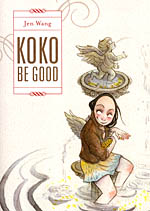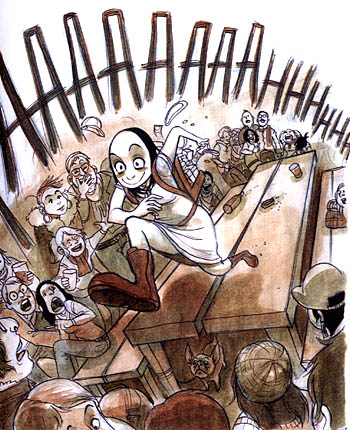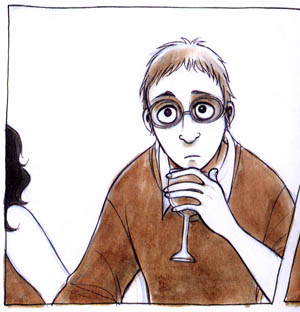 By Jen Wang
By Jen Wang
304 pages, color
Published by First Second Books
Are you a good person? Do other people see you as a good person? And what are you doing with your life anyway? They’re all questions we’ve asked ourselves at one point or another. Koko Be Good by Jen Wang uses those ideas as a launch point, and what initially looks to be a slapstick-styled book ends up being a much more thoughtful and introspective book than you might have expected as its three main characters fumble through turning points in their own lives, and what might be intended to help others doesn’t always turn out that way.
Koko Be Good is a book where our first impressions on characters don’t prove to be terribly accurate. Jon’s a man preparing to give up everything to move from San Francisco to Peru to be with the love of his life. Koko’s an energetic young woman whose entire life is a lark. Faron is Koko’s slightly goofy sidekick. Except, of course, the reality for all three turn out to be different. I think it’s safe to say that this is a deliberate storytelling point of Wang’s, since one of the ideas raised by Koko Be Good is how other people view us versus how we view ourselves. As their lives intersect throughout the book, Wang slowly shows us more about what drives the three of them and how those initial impresssions are both correct and incorrect.
 Jon and Koko share the bulk of the book’s spotlight, and for each of them there’s a distinct moment when we start to re-evaluate what we’re seeing. Their relationship throughout the book is probably one of my favorite parts of the entire experience; Wang avoids the obvious pitfalls and paths that they could go down, instead letting them each build their new lives off of one another through seeing what the other possesses that they don’t. Koko’s journey is the most pronounced here, seeing Jon’s plans to travel to another continent to help people as a jumping off point for her own life. I couldn’t help but appreciate that Wang didn’t let all of Koko’s problems miraculously fix themselves at that point, though. People she’d wronged were still mistrustful of Koko’s new passion, and heading into the world and helping people turned out to be less easy than it looked. Koko slowly transforms throughout the book from someone you’d want to steer clear of into a person that you’ll build up respect for. She’s still not perfect by any stretch of the imagination, but the Koko at the end of Koko Be Good is someone who definitely has started to turn her life around into something where her self-perception and other people’s perception might start to align.
Jon and Koko share the bulk of the book’s spotlight, and for each of them there’s a distinct moment when we start to re-evaluate what we’re seeing. Their relationship throughout the book is probably one of my favorite parts of the entire experience; Wang avoids the obvious pitfalls and paths that they could go down, instead letting them each build their new lives off of one another through seeing what the other possesses that they don’t. Koko’s journey is the most pronounced here, seeing Jon’s plans to travel to another continent to help people as a jumping off point for her own life. I couldn’t help but appreciate that Wang didn’t let all of Koko’s problems miraculously fix themselves at that point, though. People she’d wronged were still mistrustful of Koko’s new passion, and heading into the world and helping people turned out to be less easy than it looked. Koko slowly transforms throughout the book from someone you’d want to steer clear of into a person that you’ll build up respect for. She’s still not perfect by any stretch of the imagination, but the Koko at the end of Koko Be Good is someone who definitely has started to turn her life around into something where her self-perception and other people’s perception might start to align.
Jon’s story, by way of comparison, was interesting to me because he seems to at least initially be the most "together" of the three characters, but the reality of his life turns out to be much more flimsy than you’d expect. Wang is careful to seed hints along these lines throughout the first few chapters, but it’s only around the halfway point of the book (as Koko drags out of Jon more information about Emily and their plans to move to Peru) that we start to get a better glimpse of what’s going on inside Jon’s head. It’s interesting, because over time with Koko I started to empathise with her and her struggles, but with Jon I couldn’t help but feel slightly disappointed. He’s someone whose decisions are looking increasingly questionable as the book progresses, and it’s hard to say on some level how much he’s truly learned when the dust settles. So much of Jon’s story seems to be due to the actions of other characters, not Jon himself, and he still seems slightly adrift when the book comes to a close. He might be in a better place when it’s over to try and make a good life for himself, but it’s a question that Wang leaves unanswered.
 Faron, by way of comparison, has the most straight-forward story in Koko Be Good, and perhaps because of that the least amount of paget time. His story is really more of an adjunct of Koko’s, there to help move her into some specific places from time to time, than truly having his own story. It’s a shame because I’d have liked to see a little more of his life and what drives him; the glimpses we get of his home life are less than ideal, and you get the impression that Faron still has buried in him a lot of unanswered questions and motivations. Like the other characters in Koko Be Good, he’s in a better place when the book comes to a close, but perhaps because there are so many question marks still hovering over his head, he’s the one that you can worry the most about.
Faron, by way of comparison, has the most straight-forward story in Koko Be Good, and perhaps because of that the least amount of paget time. His story is really more of an adjunct of Koko’s, there to help move her into some specific places from time to time, than truly having his own story. It’s a shame because I’d have liked to see a little more of his life and what drives him; the glimpses we get of his home life are less than ideal, and you get the impression that Faron still has buried in him a lot of unanswered questions and motivations. Like the other characters in Koko Be Good, he’s in a better place when the book comes to a close, but perhaps because there are so many question marks still hovering over his head, he’s the one that you can worry the most about.
As rich as Wang’s character portraits of Jon and Koko are, though, the biggest star of all is Wang’s gorgeous art. It’s slick and smooth, sliding across the panel, filled in with rich orange and green tones. Her characters are graceful and fluid, with large eyes and smiles that light up their faces whenever something good happens. It’s a lush overall look, and there’s a lot of detail packed into her pages, from the numerous faces in the background when Koko runs across a bar table, to the occasional vista of San Francisco itself. An image as simple as Jon hunched over on his bicycle as he’s pedaling through the city ends up being beautiful, and I absolutely want to see more of Wang’s art and soon.
Koko Be Good is a book that defies easy categorization. Up until now I only knew Wang through much shorter comics in Flight anthologies, but she’s taken her talent to a new level with this book. It’s a strange little sequence of character portraits coupled with tough questions that don’t have simple answers. We may still not know what makes a person "good" or not, but one thing is certain: Koko Be Good is definitely in the "good" column.
Purchase Links: Amazon.com | Powell’s Books
